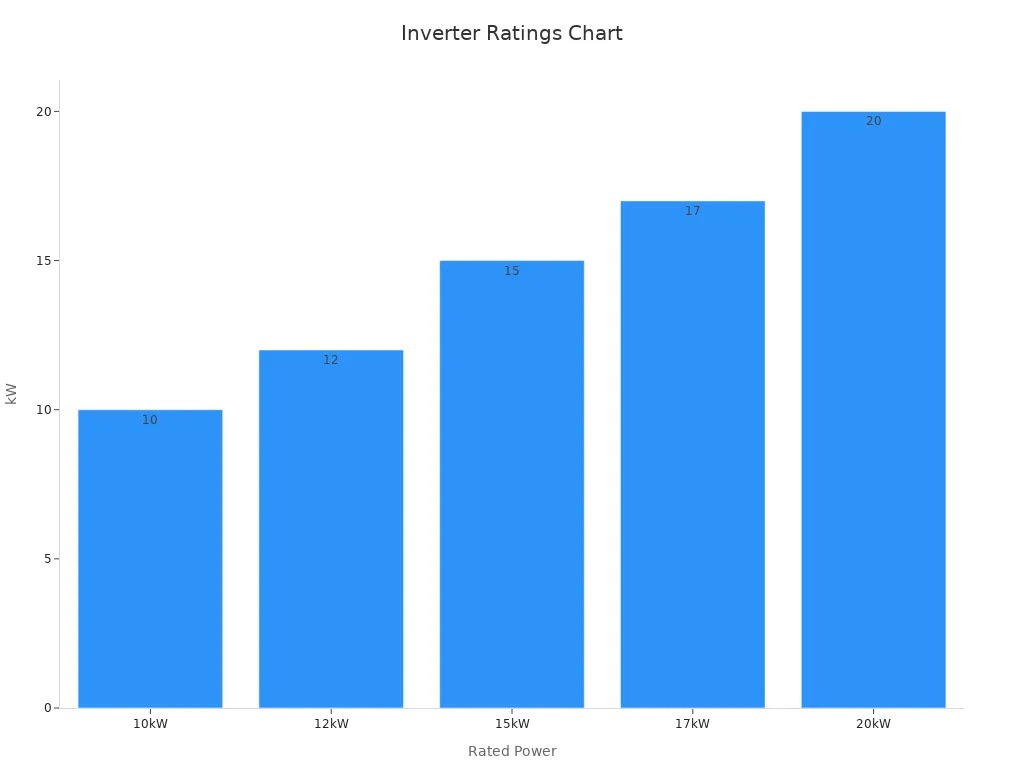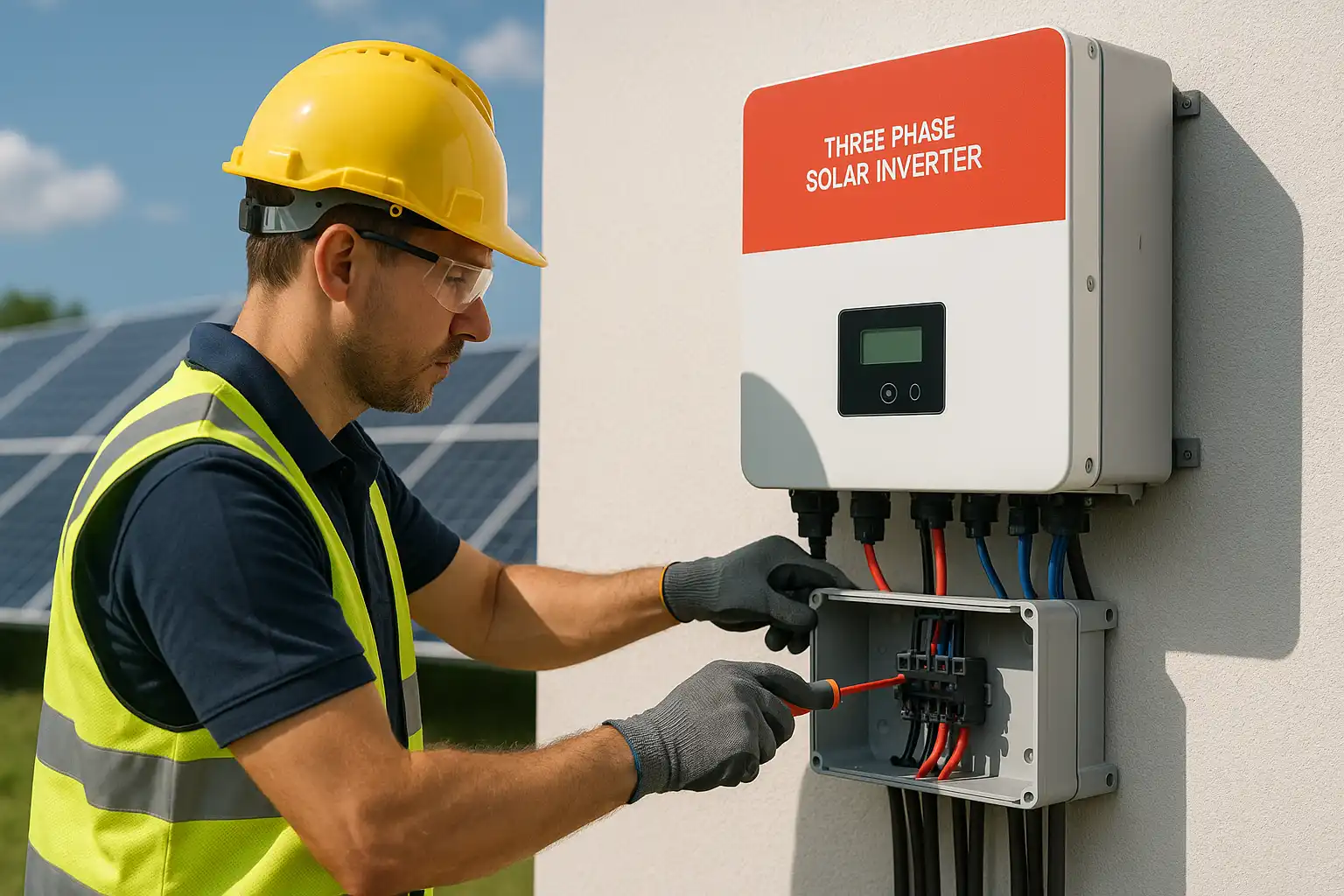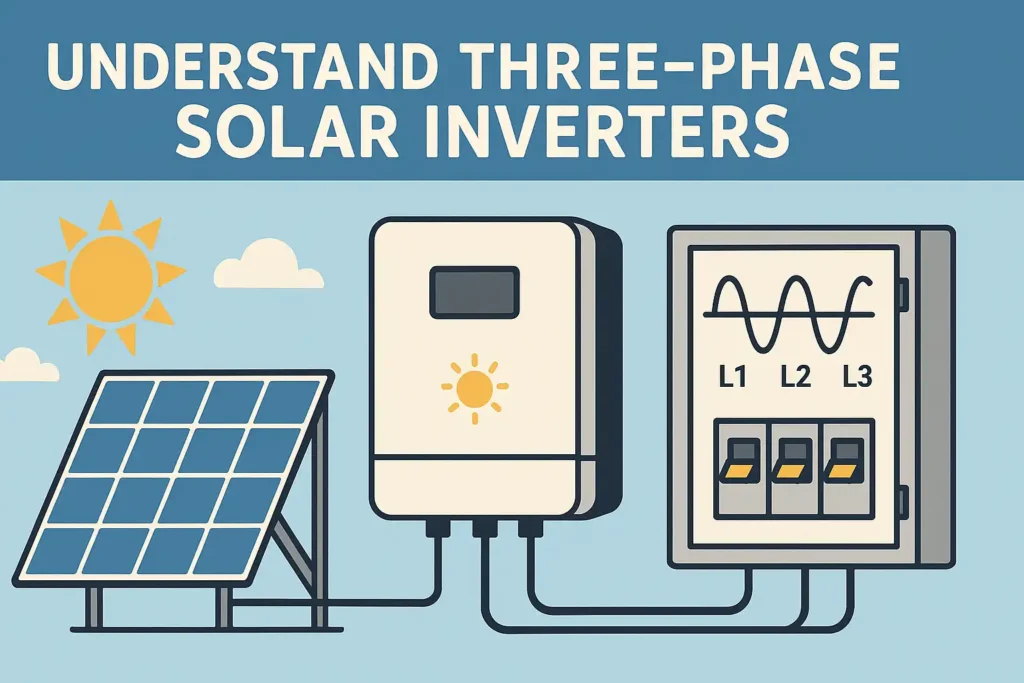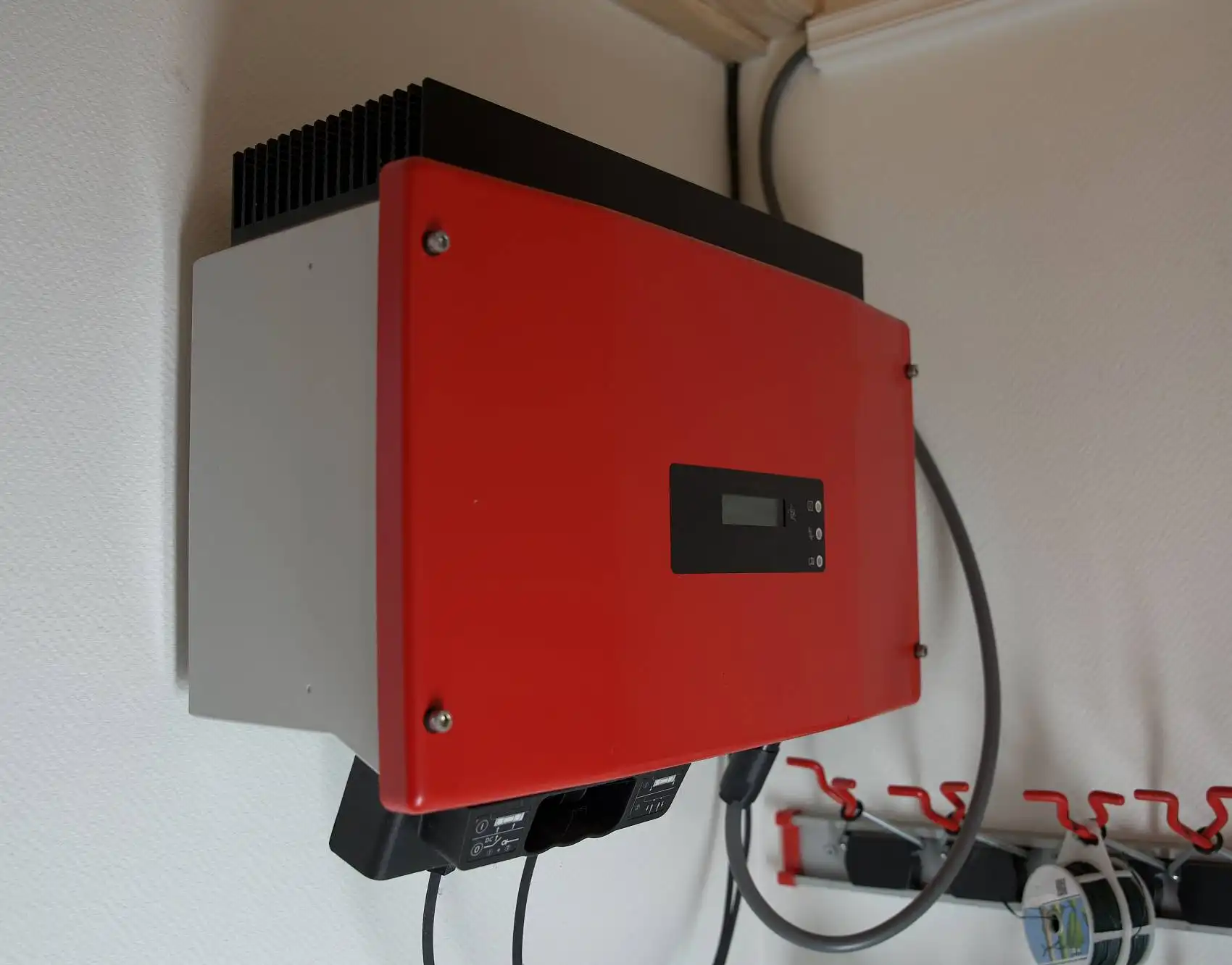A three-phase solar inverter plays a crucial role in modern solar systems. It converts direct current (DC) generated by solar panels into alternating current (AC), which is then distributed across three phases for more efficient energy utilization. This capability to manage higher power loads makes the three-phase solar inverter an ideal choice for businesses and industrial facilities.
The demand for three-phase solar inverters continues to rise as solar energy adoption accelerates globally. For instance, in 2021, renewable energy accounted for 28% of the world’s electricity, with solar energy leading the growth. By 2022, the U.S. solar market expanded by 23%, adding nearly 20 gigawatts of new solar capacity. These advancements highlight the increasing need for advanced three-phase solar inverters to manage the growing energy demands.
As solar systems become more interconnected, three-phase solar inverters equipped with IoT capabilities are evolving. They provide real-time data and enhanced communication for improved system performance.
Key Takeaways
-
Three-phase solar inverters change DC power into AC power. This power works well for businesses and factories.
-
These inverters are very efficient, up to 98.1%. This means less wasted energy and more useful power.
-
Three-phase systems give a steady energy supply. They are great for big places like factories or large buildings.
-
Think about the cost and setup when picking a three-phase inverter. They cost more and need experts to install.
-
Regular care and checks are needed to keep them working well and lasting long.
Understanding Three-Phase Power
What is three-phase power?
Three-phase power is a way to make and share electricity. It uses three alternating currents that are spaced 120 degrees apart. This setup creates a smooth and steady energy flow. Unlike single-phase systems, which use one wave of power, three-phase systems use three waves. This makes energy transfer more efficient, especially for high-power needs.
Think of a spinning magnet making electricity. As it spins, it creates three separate currents. Each current flows through its own wire. These wires work together to give steady power without stopping. For example, in a three-phase 208-volt circuit, each wire carries 120 volts. The total power is found using a formula: volts times the square root of 3 (about 1.732). This equals 208 volts, showing how efficient three-phase systems are.
Differences between single-phase and three-phase power
|
Key Differences |
Single-Phase Circuit |
Three-Phase Circuit |
|---|---|---|
|
Number of Phases |
One AC wave. |
Three AC waves, 120 degrees apart. |
|
Power Delivery |
Uneven, with ups and downs. |
Even, steady power flow. |
|
Efficiency |
Lower for big power needs. |
|
|
Power Transmission |
Not great for long distances. |
Works well over long distances. |
|
Motor Operation |
Less power and slower starts. |
More power and smoother running. |
Three-phase power is known for being reliable and efficient. It can send almost twice the power of a single-phase system. It uses the same amount of wire but works better. This makes it perfect for things like factory machines that need constant energy.
Applications of three-phase power in commercial and industrial settings
Three-phase power is very useful in factories and businesses. In manufacturing plants, it powers big machines with steady energy. This keeps everything running smoothly. Warehouses and mines also use it for equipment needing high power and speed. Offices and hotels benefit from its steady energy, which lowers costs and saves energy.
|
Sector |
Application Description |
Key Benefits |
|---|---|---|
|
Industrial |
Powers factories and warehouses. |
Keeps operations smooth and saves energy. |
|
Commercial |
Supports offices, stores, and hotels. |
Cuts costs and improves energy use. |
|
Utilities |
Used for making, sending, and sharing power. |
Helps with renewable energy and growing infrastructure. |
Three-phase power helps meet energy-saving rules. It lets businesses save money while following regulations. If you work in a factory or business, using three-phase power can improve how you manage energy.
How Three-Phase Solar Inverters Work
The conversion process from DC to AC power
A 3 phase solar inverter is important for changing solar energy. It turns direct current (DC) from solar panels into alternating current (AC) for use. Homes, businesses, and factories can use this converted power. Solar panels first collect sunlight and make DC electricity. The inverter then changes this DC into three-phase AC using advanced technology.
Here’s how the process works:
-
DC Input: The inverter gets DC power from the solar panels.
-
DC-DC Boosting: It raises the voltage to prepare for AC conversion.
-
Inversion: Special switches create a three-phase AC wave.
-
Synchronization: The output matches the grid’s frequency for smooth use.
Modern inverters are very efficient, reaching up to 98.1%. This means almost no energy is wasted during the conversion.
Below are features that improve the DC to AC conversion:
|
Feature |
Description |
|---|---|
|
Power Ratings |
10kW / 12KW / 15KW / 17KW / 20KW |
|
Efficiency |
Up to 98.1% |
|
Technology |
Advanced 3-level design |
|
MPP Tracking |
Tracks 2 Maximum Power Points |

Load distribution and efficiency in three-phase inverters
Three-phase inverters share power evenly across three lines. This balance lowers stress on the system and boosts efficiency. Unlike single-phase systems, which can have power ups and downs, three-phase systems give steady energy.
Studies show three-phase inverters work reliably. Tests using math tools like median and standard deviation confirm this. A special control method, FCS-MPCC, improves load sharing. It also reduces voltage issues and tracks current better. This ensures the inverter works well in different situations.
Balanced output reduces energy waste and protects equipment. This makes three-phase inverters great for high-power needs.
Key components of a 3 phase solar inverter
A 3 phase solar inverter has many parts that help it work well. These parts include:
-
DC Filtering Capacitance: Smooths out uneven voltage from solar panels.
-
DC Boosting Inductance: Raises voltage for AC conversion.
-
DC-Bus Capacitance: Stores energy briefly to keep the system steady.
-
AC-Side Filtering Capacitance and Inductance: Lowers noise in the AC output.
-
Internal Resistance: Helps energy flow efficiently inside the inverter.
|
Component |
Specification |
|---|---|
|
DC filtering capacitance |
|
|
DC boosting inductance |
1 mH |
|
DC-bus capacitance |
3000 μF |
|
AC-side filtering capacitance |
50 μF |
|
AC-side filtering inductance |
5 mH |
|
Internal resistance |
0.1 Ω |
Modern inverters, such as ONESTO OST 5KHB-120, have intelligent functions. These include dual MPPT and dynamic peak manager to better utilize energy. They also have Wi Fi and monitoring tools to check performance at any time.
With these parts and features, a 3 phase solar inverter ensures reliable energy conversion. It is a key part of today’s solar energy systems.
Benefits and Drawbacks of Three-Phase Solar Inverters
Advantages of three-phase inverters, including efficiency and scalability
Three-phase inverters have many benefits for high-power systems. Their top advantage is efficiency. These inverters convert 96% to 98% of solar energy into electricity. This is better than single-phase inverters, which are only 94% to 96% efficient. Less energy is wasted, so more power is usable.
Another benefit is scalability. Three-phase inverters can handle 10 kW to over 1 MW of power. This makes them great for medium and large solar setups. You can expand your system as energy needs grow without losing performance. For example, factories and offices need steady, high energy. Three-phase inverters provide stable voltage and meet these needs.
|
Feature |
Single Phase Inverter |
3 Phase Inverter |
|---|---|---|
|
Power Capacity |
Up to 10kW typical |
10kW to 1MW+ |
|
Energy Efficiency |
94-96% |
96-98% |
Three-phase inverters share power evenly across three lines. This reduces system stress and improves reliability. They are perfect for systems needing steady, high energy.
Potential drawbacks, such as cost and complexity
Despite their benefits, three-phase inverters have some downsides. One issue is cost. They are pricier than single-phase inverters because of their size and features. For small solar systems, this higher price may not be worth it.
Another downside is installation and maintenance complexity. Setting up a three-phase inverter needs careful planning. It must match your solar system and power grid. Professional help is often needed, adding to costs. Fixing these inverters also requires special skills, making repairs harder than with single-phase models.
Before choosing a three-phase inverter, think about the costs and setup challenges. Compare them with the long-term benefits of better efficiency and scalability.
Comparison of three-phase inverters with single-phase inverters
Three-phase and single-phase inverters differ in use, efficiency, and performance. Single-phase inverters are for homes and small solar setups. They are cheaper and easier to install but less efficient. They also can’t handle large energy needs.
Three-phase inverters are for businesses, factories, and big solar systems. They are more efficient, balance loads better, and support multiple solar panel strings. This makes them ideal for places with high, steady energy demands.
|
Aspect |
Single-Phase |
3-Phase Solar Inverter |
|---|---|---|
|
Applications |
Homes and small setups |
Businesses, factories, large systems |
|
Power Output |
Up to 10 KW |
|
|
Efficiency |
Lower efficiency |
Higher efficiency |
|
MPPT trackers |
One per string |
Multiple for many strings |
|
Cost |
Cheaper |
More expensive |
|
Local balancing |
Limited load handling |
Better load balancing |
For businesses or factories, a three-phase inverter is the best option. But for small homes, a single-phase inverter is cheaper and simpler to use.
Determining If You Have a Three-Phase Power Supply
How to identify a three-phase power system in your home or business
To find out if you have a three-phase power system, check your wiring. Look for three live wires and one neutral wire. These wires help share power evenly. The neutral wire keeps voltage steady and supports smaller devices. If your system uses a Wye setup, the wires meet at one point. This setup makes power sharing easier.
Here’s a simple checklist to check for a three-phase power system:
-
Look for three live wires and one neutral wire.
-
Check if the neutral wire keeps voltage steady.
-
See if the wiring uses a Wye setup.
-
Make sure the wires are in good condition to avoid problems.
If you see these features, you likely have a three-phase power system. This type of system is common in offices and buildings with elevators or large machines.
Common indicators of three-phase power
Some signs can show if you have a three-phase power system. Measuring voltage and current can help. For example, phase voltage is usually around 7.0 volts when working well. If there are problems, voltage and current may change a lot.
|
Indicator Type |
Normal Condition |
Problem Condition |
|---|---|---|
|
Phase Voltage (V) |
~7.0 V |
0 V (Phase A) |
|
Phase Current (A) |
~0.1 A |
>0.25 A |
|
Voltage Imbalance |
0.02 – 0.065 |
0.20 – 1.89 |
|
Current Imbalance |
0.03 – 0.27 |
0.10 – 2.29 |
|
Disturbance Indicators |
~0 |
0.5 – 1.99 |
|
Power Factor (PF) |
1.9 – 2.4 |
0.17 – 4.0 |
|
Maximum Deviation (PF) |
2.2 – 2.4 |
0.95 – 4.0 |
|
Line Voltage Imbalance |
~0.062 |
0.25 – 1.8 |
|
Line Current Imbalance |
~0.27 |
0.7 – 2.29 |
If the numbers are normal, your system is working fine. If not, there might be a problem needing attention.
When to seek professional assistance
Call an expert if your three-phase power system acts strangely. Problems like uneven voltage or current can mean something is wrong. Experts can check things like frequency and voltage patterns. They also look at phase angles and other details to find issues.
Here are times to call a professional:
-
Voltage or current levels are not normal.
-
Power factor numbers are far from expected.
-
Power readings seem unusual.
-
Phase angles or frequencies look off.
An electrician or solar expert can fix these problems. Regular check-ups and repairs keep your system running well. This also helps your inverter and solar setup last longer.
Installation and Compatibility of Three-Phase Solar Inverters

Things to check before installing a three-phase solar inverter
Before setting up a three-phase solar inverter, check some important things. These checks help your system work well and meet energy needs. Below is a table of key points to review:
|
Factor |
What to Check |
|---|---|
|
Make sure the inverter can handle your solar system’s power. |
|
|
Confirm the solar panels’ voltage fits the inverter’s input range. |
|
|
MPPT Capability |
Ensure the inverter can track and use the most energy from the panels. |
|
Efficiency |
Pick an inverter that converts more solar energy into usable electricity. |
|
Monitoring Features |
Choose an inverter with tools to track performance and spot problems. |
|
Grid Rules |
Check if the inverter meets grid connection rules and standards. |
|
Battery Compatibility |
Make sure the inverter works with energy storage systems like batteries. |
By checking these points, you can avoid problems and improve your solar system’s performance.
Matching with your current solar panel system
Your solar panels must work well with a three-phase inverter for smooth operation. The table below shows what to check for compatibility:
|
Compatibility Check |
What to Look For |
|---|---|
|
Voltage Match |
Ensure the inverter’s voltage range fits the solar panels to avoid issues. |
|
Panel Strings and MPPT |
Confirm the inverter works with your panel layout for better energy use. |
|
Efficiency and Power Fit |
Match the inverter’s efficiency and power rating with your solar panels to prevent damage. |
|
Communication Tools |
Make sure the inverter supports monitoring and communication for easy management. |
Always check the inverter’s specs to match your solar panels. This ensures good energy conversion and long-lasting performance.
Why professional setup and care are important
Getting a professional to install your three-phase solar inverter is very important. Experts set it up safely and follow local rules. Regular care also helps your system last longer. Here are some tips for maintenance:
-
Keep It Clean: Dust can block vents and cause overheating. Clean around the inverter often.
-
Watch Performance: Use the inverter’s tools to check energy output. A drop in energy may mean a problem.
-
Check for Damage: Look for cracks or loose wires. Call an expert if you see any issues.
Professional setup and regular care make your solar system safer and more efficient. It also helps it last longer.
Three-phase solar inverters help turn solar power into electricity. They work with over 95% efficiency, making them very dependable. These inverters share electricity across three lines evenly. This gives steady power and avoids overloads. But they cost about $300 more than single-phase inverters. Their setup is also harder, so they may not suit small systems.
Think about your system size and energy needs before choosing. For factories or businesses needing steady power, they work best. Smaller systems might save money with simpler options.
Talk to a solar expert for proper setup and advice. They can help you get the most from your solar system.
If you have a need for purchasing solar inverters, please feel free to choose ONESTO inverters – a variety of high-quality products that meet diverse application scenarios. Welcome to inquire
FAQ
What does a three-phase solar inverter do?
It changes DC power from solar panels into AC power. It spreads energy across three lines for better use in big systems.
Can homes use a three-phase solar inverter?
Yes, but it’s best for large systems. Smaller homes usually pick single-phase inverters since they are cheaper and easier.
How can you tell if your solar panels work with a three-phase inverter?
Check if the panel voltage matches the inverter’s input range. Also, make sure the inverter fits your panel setup for good energy use.
Are three-phase solar inverters hard to take care of?
They need cleaning and regular checks. Dust can block vents, and loose wires may cause trouble. Monitoring tools help find problems early, but experts keep them running well.
Why pick a three-phase solar inverter for businesses?
They handle big energy loads well. They balance power on three lines, making them great for steady energy needs in businesses.
The following information that interests you
Choosing Between Single-Phase and Three-Phase Solar Inverters
How three-phase solar inverters work in conjunction with batteries
Single Phase vs Three Phase Electricity: Which is Best for You?




